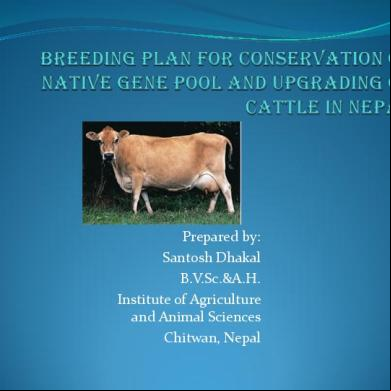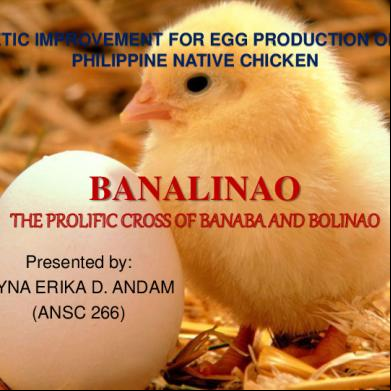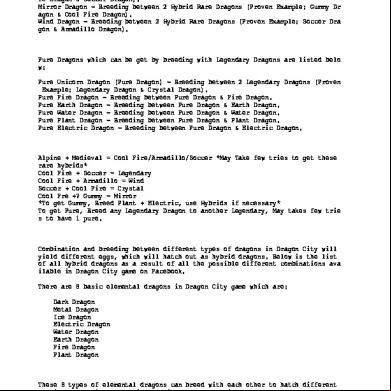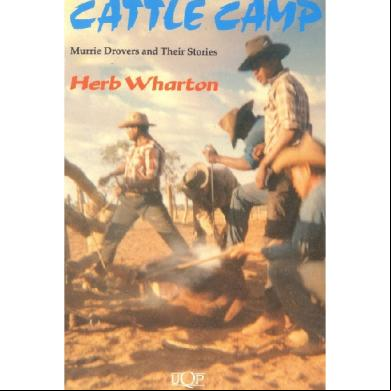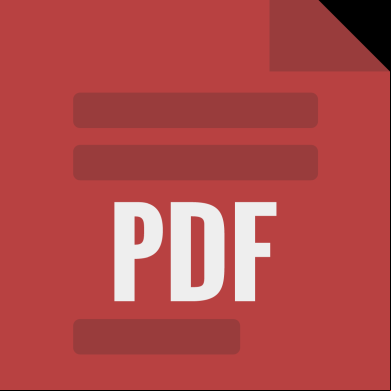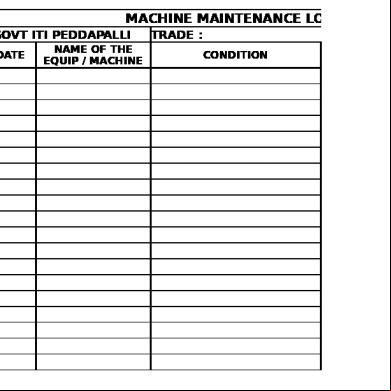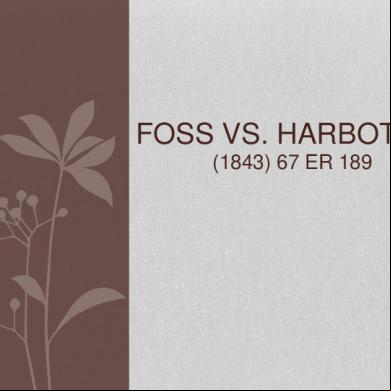Cattle Breeding Plan 612d2n
This document was ed by and they confirmed that they have the permission to share it. If you are author or own the copyright of this book, please report to us by using this report form. Report 3b7i
Overview 3e4r5l
& View Cattle Breeding Plan as PDF for free.
More details w3441
- Words: 1,517
- Pages: 20
Prepared by: Santosh Dhakal B.V.Sc.&A.H. Institute of Agriculture and Animal Sciences Chitwan, Nepal
Justification of topic Cattle are important livestock commodity in Nepal. They are mainly raised
for milk, draft and transportation purposes. Numerically, there are 7.2 million cattle in the country (statistical
information, 2009/10, MOAC). About 88% of total cattle population is indigenous. Only 13 % cattle (98,000) are milk producing.
Total milk production of the country is 1.5 million metric ton and share of
cattle to this is only 29% (429,000 MT).
The indigenous cattle population in various ecozones consists of Lulu, Achami,
Siri, Pahari, Khaila, Terai and Yak. Nepal has great diversity in cattle population, providing variation serving a raw
material for improvement.
However, the indigenous breeds are in danger of extinction due to injudicious
use of crossbreeding program and superiority of cross bred cattle compared to local breeds drawing attention towards keeping those cross bred animals. So, it is a prime necessity to preserve the genetic resource.
But, the productivity of local cattle are less as compared to exotic breeds so it
makes necessity of employing appropriate breeding strategy for upgrading local breeds with exotic breeds suitable for local production environment. Major exotic breeds (whose crosses are common) of cattle dominating in Nepal
are Jersey and Holstein Friesian. So breeding plan should incorporate one of them.
Breed
Distribution
LuLu\kirko
High mountain of western and eastern terai, Mustang
Achhami
Western part of hills , Achham district
Siri
High areas of eastern region
Pahari
Found in mountain, hills and terai
Chauri cows
Mountain and hills
Yak and nak
High mountain
why upgrading is necessary ???? Breeds
Age at first Age at 1st Gestation service(mth) calving(mth) length(days)
Lulu
42
Acchmi
48
52
Calving Av. Daily Lactation interval (mth) milk yield(lt) length(days)
280±1.7
18
1.6±.31
195
285±1.8
17
1.5±.22
225
4.5±.22
268.6±2
2.5
305
60 Siri
40
295.2±2.2
19.6±.9
50 Khaila
45
288±1.85
18
55 Pahadi
48
50.1±1.1
275±1.65
17.6±1.65
1.1
240±2.1
Terai
39.4±0.5
49.9±0.46
296.1±.25
16.3±.23
2.1
246
Yak
45.3±.65
56.6±.75
252.2±1.5
21.3±.76
0.8
160
Developing breeding plan Formulation of Breeding Objectives
Deciding what is to achieve ? The present need of cattle industry of Nepal are : To conserve indigenous genetic resource To increase the milk production with high fat percentage To improve the body configuration To increase the feed efficiency To decrease the generation interval and age of first calving To increase lactation length To reduce calving interval etc.
Choice of breed and breeding system All indigenous breeds of cattle mentioned above for maintaining germ plasm and jersey breed for upgrading. Breeding system The breeding system will involve two steps: Line breeding of indigenous breeds at their particular production
environment in order to conserve the native germplasm Cross breeding of selected females of local breed with suitable other exotic
or local breeds as per necessity of the production environment
For bringing exotic breed into the native gene pool the 3 tier breeding scheme will be used.
Nucleus: breeding unit in the exporting country ( for 100%jersey semen)
Multiplier: breeding unit in the country at various ecozones
Producer: producing ( commercial ) unit in the country at particular
ecozones
Selection of individuals Selection differential, heritability, genetic gain, selection index and
other parameters will be determined on each generation mainly based on milk production and fat percentage. This increase milk production with higher fat percentage, shorter calving interval, longer lactational yield all has positive economic values. The animals will be evaluated based on its own production and pedigree records, based on milk yield, fat percentage, disease resistance characters. Certain healthy animals, productive (fertile) female animals of local cattle will be the population for improvement and for male; the jersey bulls will be chosen. 5% males will be selected as replacement sire and 50-60% female as replacement heifer
Mating for Selected Animals Indigenous germplam will be preserved by line breeding
For cross breeding (grading up) all the female cattle selected will be
inseminated by the semen of pure breed jersey bulls or semen of other local breeds as per necessary and progenies will be selected on the basis of breed characters.
For cross breeding with jersey breed repeated back crossing will be
employed to achieve the required blood level i.e. more than 75%
Design System of Expansion
For every breed the line breeding will be carried out on research station or
germplasm conservation centers established at respective ecological zones.
Then, the cross breeding with other suitable local breeds or jersey will be
carried out on the multiplier herd at respective production environment. The animal which will not meet our criteria will be culled out.
Methodology Siri breed: siri breed is somewhere said to not exist in Nepal. For this,
identification, characterization is necessary followed by conservation by line breeding then only grading up can be considered. After maintaining pure line of this breed crossing with jersey to maintain 75% blood level of jersey. Acchami cattle: The genetic improvement strategy for for Acchami cattle
should be dedicated in maintaining purity by line breeding and then at commercial level crossing with hill cattle can be practiced. For Lulu, Pahadi, Khaila and Terai, line breeding will be done at germpalsm
conservation center established at high mountain ( mustang), hills, mountain and terai region respectively. For commercially improving productivity grading up will be done with jersey semen use by artificial insemination upto 75% blood level for lulu, pahadi and khaila and 87.25% blood level to terai breed.
For yak: Pure-breeding is the predominant practice with yak. The aim should be to improve the breed for meat and hair. Scores are allocated for aspects of general conformation, the body, testes for
males and udder for females, legs, feet and the coat. Calves and adults are graded to somewhat different criteria. Weight and height classes are designed according to age and sex of animal. The use of selected breeding bulls is recommended, and newborn animals may be
assigned a grade on the basis of the grades of their parents. Nucleus herd and multiplier herd scan be established in high Himalayan region
for genetic improvement program.
An example of genetic improvement program and its effect Lets consider grading up of local cattle breed say, terai and exotic cattle breed
jersey for improving milk production. The milk production traits are medium to high in heritability in cattle indicating
additive and nonadditive genetic effect both. Progress can be made by selection and breeding. The cross breeding will be carried to maintain 87.5% blood level of jersey.
3 successive generations crossing of female with 100% pure jersey male will be
carried out at multiplier herd established at different districts of Terai region as per requirement.
Same procedure will be disseminated to commercial level.
MALE
FEMALE
JERSEY 100%
TERAI 100%
TERAI 50% JERSEY 50%
JERSEY 100%
TERAI 25% JERSEY 75%
JERSEY 100%
TERAI 12.5% JERSEY 87.5%
Records available for the population of jersey and local
cattle is POPULATION A (HERD FROM WHICH MALES WERE SELECTED
POPULATION B (HERD
FROM
SELECTED)
HERD AVERAGE
3000KG
1500
STANDARD DEVIATION 400
300
Heritability
0.35
0.3
Generation Interval 2.5 years
3 years
Population selected 5%
60%
WHICH
FEMALES
WERE
Genetic gain per generation GG/Gen=95.4kg Total GG/yr =35.9kg milk Herd average = [Av.Production of Dam (for male selection)
+ Av.production of female 2 = 3000 + 1500 2 = 2250 kg Average expected production = herd average + GG\Gen = 2250 + 95.4 =2345.4 Kg Thus, average expected production is 2345.4 Kg.
Conclusion and suggestions: Nepal has its own diverse genetic material with high variation providing a
raw material for genetic progress. These indigenous genetic resources have additional benefit of disease
resistance, hardiness and other characters suitable for local environment due to continuous selection pressure imposed by nature itself. However, these genetic resources are in danger of extinction because of
indiscriminate breeding programs and comparative benefit of other cross bred or pure exotic breeds of cattle. Conserving the native gene pool of cattle breed is the responsibility of government and it should launch an effective program for identification, characterization and preservation of these indigenous genetic resources of cattle. Line breeding can be considered for improvement of local breeds of cattle by
opening research and germplasm conservation stations at various ecozones.
Commercially, cross bred animals especially with jersey are found to be
beneficial due to their high lactational milk yield. Due to this, cross breeding with Jersey should be carried out as means of upgrading the local cattle. Governmental sector should formulate proper breeding strategy to address
different ecological zones and breeds available there. Establishment of multiplier herds at different ecozones may be considered
for ensuring judicious use of breeding program at farmers’ level to bring white revolution for overall development of country and alleviation of poverty. Suitable inbreeding strategy should be initiated to conserve gene pool of yak
population.
Justification of topic Cattle are important livestock commodity in Nepal. They are mainly raised
for milk, draft and transportation purposes. Numerically, there are 7.2 million cattle in the country (statistical
information, 2009/10, MOAC). About 88% of total cattle population is indigenous. Only 13 % cattle (98,000) are milk producing.
Total milk production of the country is 1.5 million metric ton and share of
cattle to this is only 29% (429,000 MT).
The indigenous cattle population in various ecozones consists of Lulu, Achami,
Siri, Pahari, Khaila, Terai and Yak. Nepal has great diversity in cattle population, providing variation serving a raw
material for improvement.
However, the indigenous breeds are in danger of extinction due to injudicious
use of crossbreeding program and superiority of cross bred cattle compared to local breeds drawing attention towards keeping those cross bred animals. So, it is a prime necessity to preserve the genetic resource.
But, the productivity of local cattle are less as compared to exotic breeds so it
makes necessity of employing appropriate breeding strategy for upgrading local breeds with exotic breeds suitable for local production environment. Major exotic breeds (whose crosses are common) of cattle dominating in Nepal
are Jersey and Holstein Friesian. So breeding plan should incorporate one of them.
Breed
Distribution
LuLu\kirko
High mountain of western and eastern terai, Mustang
Achhami
Western part of hills , Achham district
Siri
High areas of eastern region
Pahari
Found in mountain, hills and terai
Chauri cows
Mountain and hills
Yak and nak
High mountain
why upgrading is necessary ???? Breeds
Age at first Age at 1st Gestation service(mth) calving(mth) length(days)
Lulu
42
Acchmi
48
52
Calving Av. Daily Lactation interval (mth) milk yield(lt) length(days)
280±1.7
18
1.6±.31
195
285±1.8
17
1.5±.22
225
4.5±.22
268.6±2
2.5
305
60 Siri
40
295.2±2.2
19.6±.9
50 Khaila
45
288±1.85
18
55 Pahadi
48
50.1±1.1
275±1.65
17.6±1.65
1.1
240±2.1
Terai
39.4±0.5
49.9±0.46
296.1±.25
16.3±.23
2.1
246
Yak
45.3±.65
56.6±.75
252.2±1.5
21.3±.76
0.8
160
Developing breeding plan Formulation of Breeding Objectives
Deciding what is to achieve ? The present need of cattle industry of Nepal are : To conserve indigenous genetic resource To increase the milk production with high fat percentage To improve the body configuration To increase the feed efficiency To decrease the generation interval and age of first calving To increase lactation length To reduce calving interval etc.
Choice of breed and breeding system All indigenous breeds of cattle mentioned above for maintaining germ plasm and jersey breed for upgrading. Breeding system The breeding system will involve two steps: Line breeding of indigenous breeds at their particular production
environment in order to conserve the native germplasm Cross breeding of selected females of local breed with suitable other exotic
or local breeds as per necessity of the production environment
For bringing exotic breed into the native gene pool the 3 tier breeding scheme will be used.
Nucleus: breeding unit in the exporting country ( for 100%jersey semen)
Multiplier: breeding unit in the country at various ecozones
Producer: producing ( commercial ) unit in the country at particular
ecozones
Selection of individuals Selection differential, heritability, genetic gain, selection index and
other parameters will be determined on each generation mainly based on milk production and fat percentage. This increase milk production with higher fat percentage, shorter calving interval, longer lactational yield all has positive economic values. The animals will be evaluated based on its own production and pedigree records, based on milk yield, fat percentage, disease resistance characters. Certain healthy animals, productive (fertile) female animals of local cattle will be the population for improvement and for male; the jersey bulls will be chosen. 5% males will be selected as replacement sire and 50-60% female as replacement heifer
Mating for Selected Animals Indigenous germplam will be preserved by line breeding
For cross breeding (grading up) all the female cattle selected will be
inseminated by the semen of pure breed jersey bulls or semen of other local breeds as per necessary and progenies will be selected on the basis of breed characters.
For cross breeding with jersey breed repeated back crossing will be
employed to achieve the required blood level i.e. more than 75%
Design System of Expansion
For every breed the line breeding will be carried out on research station or
germplasm conservation centers established at respective ecological zones.
Then, the cross breeding with other suitable local breeds or jersey will be
carried out on the multiplier herd at respective production environment. The animal which will not meet our criteria will be culled out.
Methodology Siri breed: siri breed is somewhere said to not exist in Nepal. For this,
identification, characterization is necessary followed by conservation by line breeding then only grading up can be considered. After maintaining pure line of this breed crossing with jersey to maintain 75% blood level of jersey. Acchami cattle: The genetic improvement strategy for for Acchami cattle
should be dedicated in maintaining purity by line breeding and then at commercial level crossing with hill cattle can be practiced. For Lulu, Pahadi, Khaila and Terai, line breeding will be done at germpalsm
conservation center established at high mountain ( mustang), hills, mountain and terai region respectively. For commercially improving productivity grading up will be done with jersey semen use by artificial insemination upto 75% blood level for lulu, pahadi and khaila and 87.25% blood level to terai breed.
For yak: Pure-breeding is the predominant practice with yak. The aim should be to improve the breed for meat and hair. Scores are allocated for aspects of general conformation, the body, testes for
males and udder for females, legs, feet and the coat. Calves and adults are graded to somewhat different criteria. Weight and height classes are designed according to age and sex of animal. The use of selected breeding bulls is recommended, and newborn animals may be
assigned a grade on the basis of the grades of their parents. Nucleus herd and multiplier herd scan be established in high Himalayan region
for genetic improvement program.
An example of genetic improvement program and its effect Lets consider grading up of local cattle breed say, terai and exotic cattle breed
jersey for improving milk production. The milk production traits are medium to high in heritability in cattle indicating
additive and nonadditive genetic effect both. Progress can be made by selection and breeding. The cross breeding will be carried to maintain 87.5% blood level of jersey.
3 successive generations crossing of female with 100% pure jersey male will be
carried out at multiplier herd established at different districts of Terai region as per requirement.
Same procedure will be disseminated to commercial level.
MALE
FEMALE
JERSEY 100%
TERAI 100%
TERAI 50% JERSEY 50%
JERSEY 100%
TERAI 25% JERSEY 75%
JERSEY 100%
TERAI 12.5% JERSEY 87.5%
Records available for the population of jersey and local
cattle is POPULATION A (HERD FROM WHICH MALES WERE SELECTED
POPULATION B (HERD
FROM
SELECTED)
HERD AVERAGE
3000KG
1500
STANDARD DEVIATION 400
300
Heritability
0.35
0.3
Generation Interval 2.5 years
3 years
Population selected 5%
60%
WHICH
FEMALES
WERE
Genetic gain per generation GG/Gen=95.4kg Total GG/yr =35.9kg milk Herd average = [Av.Production of Dam (for male selection)
+ Av.production of female 2 = 3000 + 1500 2 = 2250 kg Average expected production = herd average + GG\Gen = 2250 + 95.4 =2345.4 Kg Thus, average expected production is 2345.4 Kg.
Conclusion and suggestions: Nepal has its own diverse genetic material with high variation providing a
raw material for genetic progress. These indigenous genetic resources have additional benefit of disease
resistance, hardiness and other characters suitable for local environment due to continuous selection pressure imposed by nature itself. However, these genetic resources are in danger of extinction because of
indiscriminate breeding programs and comparative benefit of other cross bred or pure exotic breeds of cattle. Conserving the native gene pool of cattle breed is the responsibility of government and it should launch an effective program for identification, characterization and preservation of these indigenous genetic resources of cattle. Line breeding can be considered for improvement of local breeds of cattle by
opening research and germplasm conservation stations at various ecozones.
Commercially, cross bred animals especially with jersey are found to be
beneficial due to their high lactational milk yield. Due to this, cross breeding with Jersey should be carried out as means of upgrading the local cattle. Governmental sector should formulate proper breeding strategy to address
different ecological zones and breeds available there. Establishment of multiplier herds at different ecozones may be considered
for ensuring judicious use of breeding program at farmers’ level to bring white revolution for overall development of country and alleviation of poverty. Suitable inbreeding strategy should be initiated to conserve gene pool of yak
population.
